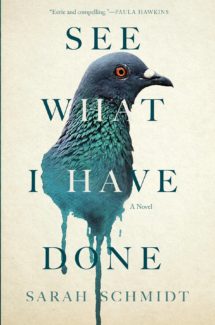Lizzie Borden Took An Axe
Author: Sarah Schmidt
 On August 4th, 1892 two brutal murders shook the ever so proper town of Fall River, Massachusetts and have since gone down as one of the most violent and unexplained homicides in America. I am, of course, talking about the infamous Lizzie Borden debacle. Lizzie, the peculiar “old-maid,” may have been tried and acquitted for the axe-murder of her father and stepmother but legend and popular opinion say otherwise. Who else, on that sultry summer day, had the opportunity? Who else had the motive? And so, Sarah Schmidt wants to give us some food for thought. Yes – Lizzie could have done it. But what about the other shifty characters in the close doored Borden home?
On August 4th, 1892 two brutal murders shook the ever so proper town of Fall River, Massachusetts and have since gone down as one of the most violent and unexplained homicides in America. I am, of course, talking about the infamous Lizzie Borden debacle. Lizzie, the peculiar “old-maid,” may have been tried and acquitted for the axe-murder of her father and stepmother but legend and popular opinion say otherwise. Who else, on that sultry summer day, had the opportunity? Who else had the motive? And so, Sarah Schmidt wants to give us some food for thought. Yes – Lizzie could have done it. But what about the other shifty characters in the close doored Borden home?
Schmidt opens with the gore – the finding of the body by a semi-distraught, semi-mentally absent and obsessive Lizzie; we see the blood on the couch, the prone figure obviously dead, and so enter into the strange atmosphere of this surreal novel where the heat and the confusion combine. Schmidt’s Lizzie is more child than adult, while the real-life Lizzie, during her trial, expressed herself as an unfeeling, stoic, give-nothing-away, show no sorrow type of person. Yet here, our character is childish, needy, bestowed with the physical capabilities of a grown woman, but who hates and thinks and parses information in a childlike fashion. Lizzie doesn’t understand then, is incapable of understanding even upon seeing her slain father, that he is dead. And so here enters Emma, the adult who can function and understand as an adult.
 The elder and wiser of the two sisters, Emma was away at the time of the murder and, secretly, planning to stay away from a household infected by parsimony and the ever latching hands of her younger sister, a sinister little figure almost supernatural in her petty hatefulness. This Emma has her doubts, and her suspicions. And now, her dream of running away from all of them is once again ruined. Probably, she thinks, by Lizzie.
The elder and wiser of the two sisters, Emma was away at the time of the murder and, secretly, planning to stay away from a household infected by parsimony and the ever latching hands of her younger sister, a sinister little figure almost supernatural in her petty hatefulness. This Emma has her doubts, and her suspicions. And now, her dream of running away from all of them is once again ruined. Probably, she thinks, by Lizzie.
Bridget Sullivan, the house’s only servant, has likewise been planning an escape. Mrs. Borden is vitriolic, her husband violent and abrasive, the daughters both weird and disconcerting. The house is a sweltering den of ill cooked food, sickness, and the sort of festering that only happens in bad families. When Mrs. Borden, however, grabs and hides all her money, Bridget’s escape plan is also ruined, her return to her homeland once again just a fantasy
Then, there is Uncle Benjamin, the brother of Andrew’s first wife and a man who is used to paying for his dirty deeds. He isn’t fond of the way Andrew treats his nieces, and a useful new connection has been hired to sort out the mess. Only, the man just may have gone too far.
All together, the voices of the three women merge with this new player in the Borden saga, a hired assassin with daddy issues of his own. As the stories wind around each other then, the voices talking over and tumbling around each other in the nauseating atmosphere speckled with reheated mutton broth and endless sickness, the slow decay of a family emerges yet the murders, and the ultimate ax wielding fiend, end, once again, as a mystery. Only this time, the author has us realizing that everyone related to this sordid business had the capability to deliver those 40 whacks.
The story is gripping, mostly in what it relies upon historically. You mention Lizzie Borden and the jingle begins in our heads, the idea of an old-school proper lady transforming into an axe murdering patricide. The atmosphere here, and the way the story could have unfolded, is where the author makes this near urban legend her own. What we have is a strange mélange of facts, long term suspicions, and brand new ideas.
Schmidt adds an extra motive, and an explanation for why the axe, with the introduction of Lizzie’s pet pigeons who, you guessed it, fall prey to an angry Andrew the day before the same axe he used on Lizzie’s birds ends his own life. It’s an interesting addition, although easily disproven. It does, slightly, harken back to the idea during the actual trial that the blood on the handless hatchet (one of the suspected, although never validated possibles for the murder weapon) belonged to an animal and not the unfortunate Bordens. The author also has her own twist with Emma’s and Lizzie’s eventual split, and she never mentions the sensational attempt of Lizzie to buy poison (allegedly to clean a seal-skin cape) several days before the murder. Understandable literary choices, each, and for the most part effective in staying true to this volume’s aura.
 Schmidt does choose to explore the idea of the unknown and seemingly unmotivated outside party (a real possible in the actual trial) alongside the shady Uncle in the form of the fourth voice in the narrative, that of the assassin. Schmidt also gives Bridget a motive, but never really singles her out as the probable culprit.
Schmidt does choose to explore the idea of the unknown and seemingly unmotivated outside party (a real possible in the actual trial) alongside the shady Uncle in the form of the fourth voice in the narrative, that of the assassin. Schmidt also gives Bridget a motive, but never really singles her out as the probable culprit.
What disappoints, although it fits with the everyone-is-a-suspect approach, is that the actual how-did-it-happen is never clear. Schmidt’s final assessment seems to be on Lizzie, in some sort of odd dance in between all the other wannabe murderers, although she is never truly clear on that idea. This ultimately works, although we, as readers, leave a bit disappointed. There is never a definite in the Borden story, even when fiction takes the wheel and can supposedly dictate the events. We never see the actual murders or know how everything happened, although we do know how it all ended (badly, at least for Andrew and Abbey). The door closes here, as it does in history, and we are still left with a mystery and the same probable but unconfirmed suspect.
Another element that both works and doesn’t is the novel’s chosen atmosphere. Like the actual time of the murder, it’s close. Hot and bubbling with hidden resentments. But then there is also the endless food – the hot mutton on hot days, its own slow decay making the inhabitants sick – and the constant retching and descriptions of vomit, an undertone of sickly sweetness in among the coppery scent of murder. It’s not a book to have snack with, and ultimately heavy handed in places, trying to be disgusting to an unnecessary degree. Que – enough descriptions of vomit.
Ultimately, See What I Have Done is a decent nod to the prevailing mystery, with its own intensive insight into the dysfunctional Borden house and all the many things that might have led up to Andrew and Abby suspended, seemingly forever, in a pool of growing blood. It’s a good book, if not always accurate to the history and the subtleties, even as it too shies away from giving that final answer.
– Frances Carden
Follow my reviews on Twitter at: https://twitter.com/xombie_mistress
Follow my reviews on Facebook at: https://www.facebook.com/FrancesReviews/
[AMAZONPRODUCTS asin=”0802128130″]
- Book Vs Movie: The Shining - April 6, 2020
- Thankful For Great Cozy Mysteries - December 13, 2019
- Cozy Mysteries for a Perfect Fall - October 20, 2019


